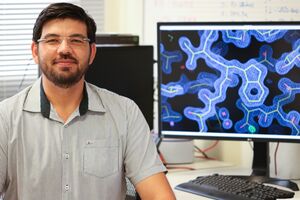CAZypedia needs your help! We have many unassigned GH, PL, CE, AA, GT, and CBM pages in need of Authors and Responsible Curators.
Scientists at all career stages, including students, are welcome to contribute to CAZypedia. Read more here, and in the 10th anniversary article in Glycobiology.
New to the CAZy classification? Read this first.
*
Consider attending the 15th Carbohydrate Bioengineering Meeting in Ghent, 5-8 May 2024.
User:Mario Murakami
Mario Murakami is the scientific director of the Brazilian Biorenewables National Laboratory (since 2018) and former coordinator of the macromolecular crystallography village at the Brazilian National Center for Research in Energy and Materials (2010-2017). He obtained Ph.D. degree in molecular biophysics (2006) from the State University of São Paulo with a split Ph.D. at the University of Hamburg and German Electron Synchrotron DESY. He worked with the structural elucidation of macromolecular complexes involved in the inhibition and activation of enzymes during his post-docs at UNESP and Rutgers University. His current research interests encompass the discovery and mechanistic understanding of CAZymes and the genetic engineering of filamentous fungi for enzyme production. He has contributed to structure and function studies of CAZymes from families GH1[1, 2, 3, 4, 5, 6], GH2, GH3, GH5, GH7, GH8, GH10, GH11, GH12, GH22, GH39, GH43, GH42 GH45, GH51, GH54, GH57, GH128 and AA9.
- de Giuseppe PO, Souza Tde A, Souza FH, Zanphorlin LM, Machado CB, Ward RJ, Jorge JA, Furriel Rdos P, and Murakami MT. (2014). Structural basis for glucose tolerance in GH1 β-glucosidases. Acta Crystallogr D Biol Crystallogr. 2014;70(Pt 6):1631-9. DOI:10.1107/S1399004714006920 |
- Crespim E, Zanphorlin LM, de Souza FH, Diogo JA, Gazolla AC, Machado CB, Figueiredo F, Sousa AS, Nóbrega F, Pellizari VH, Murakami MT, and Ruller R. (2016). A novel cold-adapted and glucose-tolerant GH1 β-glucosidase from Exiguobacterium antarcticum B7. Int J Biol Macromol. 2016;82:375-80. DOI:10.1016/j.ijbiomac.2015.09.018 |
- Santos CA, Zanphorlin LM, Crucello A, Tonoli CCC, Ruller R, Horta MAC, Murakami MT, and de Souza AP. (2016). Crystal structure and biochemical characterization of the recombinant ThBgl, a GH1 β-glucosidase overexpressed in Trichoderma harzianum under biomass degradation conditions. Biotechnol Biofuels. 2016;9:71. DOI:10.1186/s13068-016-0487-0 |
- Zanphorlin LM, de Giuseppe PO, Honorato RV, Tonoli CC, Fattori J, Crespim E, de Oliveira PS, Ruller R, and Murakami MT. (2016). Oligomerization as a strategy for cold adaptation: Structure and dynamics of the GH1 β-glucosidase from Exiguobacterium antarcticum B7. Sci Rep. 2016;6:23776. DOI:10.1038/srep23776 |
- Toyama D, de Morais MAB, Ramos FC, Zanphorlin LM, Tonoli CCC, Balula AF, de Miranda FP, Almeida VM, Marana SR, Ruller R, Murakami MT, and Henrique-Silva F. (2018). A novel β-glucosidase isolated from the microbial metagenome of Lake Poraquê (Amazon, Brazil). Biochim Biophys Acta Proteins Proteom. 2018;1866(4):569-579. DOI:10.1016/j.bbapap.2018.02.001 |
- Santos CA, Morais MAB, Terrett OM, Lyczakowski JJ, Zanphorlin LM, Ferreira-Filho JA, Tonoli CCC, Murakami MT, Dupree P, and Souza AP. (2019). An engineered GH1 β-glucosidase displays enhanced glucose tolerance and increased sugar release from lignocellulosic materials. Sci Rep. 2019;9(1):4903. DOI:10.1038/s41598-019-41300-3 |
